That year HELCO reappeared in the desert and attempted to buy out Burning Man. I wrote an announcement for our newsletter that introduced the theme and quote from it below.
Welcome to Hell
Through me you enter into the city of woes,
Through me you enter into eternal pain,
Through me you enter the population of loss,
Abandon all hope, you who enter here. — Dante Alighieri
This year in the Black Rock Desert the Burning Man Project presents The Inferno – a rendering of Hell in our postmodern age. The place we know as Hell has been portrayed in many ways. It is most frequently an after-world, an abode of the dead, and one’s journey through it is a trial or initiation. Our own interpretation is adapted from the Hell of Dante Alighieri as it derives from Hades, the underworld of ancient Greece. Guarded by terrifying monsters – the Furies, Medusa, and Cerberus, the three-headed dog of Hell – it will be a place where every sin and folly of our age is catalogued, held up for public view, and punished… Most fundamentally, throughout successive ages Hell has been a place of banishment. Whatever we wish to cast out of our world or out of ourselves is here destined to reappear and confront us. Unlike Heaven, the home of the perfect, Hell is, and will always be, a supremely ironic place.
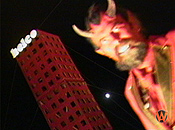 On Saturday night we staged a little show in central camp. Flash reprised his role, now known as Papa Satan. He sat stage right upon a throne surrounded by beguiling temptresses. Behind him stood a group of corporate mascots. They represented HELCO’s board of directors. I remember Aunt Jemima, the Jolly Green Giant, and Mr. Klean. Will Roger played Mr. Klean. Clutching a rag and a spray bottle filled with kerosene, he at one point set fire to the stage. Our skit was structured as a kind of fairy tale. Three times I was tempted to sign over the property rights to Burning Man and Black Rock City by HELCO’s attorney, played by Stuart Mangram. Three times I refused and reeled back. Turning toward the audience, pen and contract still in hand, I finally shouted, “I can’t sign this! I don’t own Black Rock City! Burning Man belongs to all of you! You have to decide!” Everyone present, of course, opted not to sell out. Satan was then chained to the back of a truck and trundled off at the head of a procession into the Inferno.
On Saturday night we staged a little show in central camp. Flash reprised his role, now known as Papa Satan. He sat stage right upon a throne surrounded by beguiling temptresses. Behind him stood a group of corporate mascots. They represented HELCO’s board of directors. I remember Aunt Jemima, the Jolly Green Giant, and Mr. Klean. Will Roger played Mr. Klean. Clutching a rag and a spray bottle filled with kerosene, he at one point set fire to the stage. Our skit was structured as a kind of fairy tale. Three times I was tempted to sign over the property rights to Burning Man and Black Rock City by HELCO’s attorney, played by Stuart Mangram. Three times I refused and reeled back. Turning toward the audience, pen and contract still in hand, I finally shouted, “I can’t sign this! I don’t own Black Rock City! Burning Man belongs to all of you! You have to decide!” Everyone present, of course, opted not to sell out. Satan was then chained to the back of a truck and trundled off at the head of a procession into the Inferno.
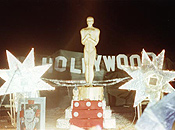 Thousands filed through the Gates of Hell, created by Kal Spelletich. It looked like an array of toll booths on a freeway. Overhead, I’d asked him to emblazon Dante’s famous admonition in neon lettering: “Abandon all hope, you who enter here.” Kal also created Cerberus, the three-headed hound of Hell, an animated fire spewing sculpture made of metal. As participants descended deeper into the Inferno, they passed an installation created by the Reverend Al. Entitled Tinseltown, it modeled the Hollywood Hills, complete with their famous sign. The area fronting this backdrop featured various cut-out movie idols, edgy music intermixed with drifting riffs of dialogue from classic films, and sported my favorite feature, The Incredible Exploding Box Office. It did, in fact, explode, spewing rockets outward toward the audience at angles nearly level with the crowd (we later discussed this with Al).
Thousands filed through the Gates of Hell, created by Kal Spelletich. It looked like an array of toll booths on a freeway. Overhead, I’d asked him to emblazon Dante’s famous admonition in neon lettering: “Abandon all hope, you who enter here.” Kal also created Cerberus, the three-headed hound of Hell, an animated fire spewing sculpture made of metal. As participants descended deeper into the Inferno, they passed an installation created by the Reverend Al. Entitled Tinseltown, it modeled the Hollywood Hills, complete with their famous sign. The area fronting this backdrop featured various cut-out movie idols, edgy music intermixed with drifting riffs of dialogue from classic films, and sported my favorite feature, The Incredible Exploding Box Office. It did, in fact, explode, spewing rockets outward toward the audience at angles nearly level with the crowd (we later discussed this with Al).
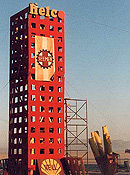 I also worked with Flynn Mauthe, who built the much-photographed HELCO Tower. Flynn constructed a big box in imitation of a high-rise (this is practically all of the direction that I gave him). He painted it bright red. Overhead it bore the name HELCO in huge illuminated letters (scavenged from a Payless shoe store sign). Its fenestration made it appear to be nearly twice as tall as its actual height. This structure was surrounded by installations, each a parody of some well-known franchise outlet. The HELCO Tower was ignited and, as racing flames began to sheath its sides, a silhouetted human figure now appeared atop it. This was John Law, one of our chief organizers. I had suggested to John that he wear a Santa suit. Instead, he chose to wear a Western duster. John was an experienced daredevil. He waited till the fire threatened to engulf him. Then, leaping into the darkness, the duster flapping like a pair of raven wings behind him, he plummeted down a zip line and crashed through an illuminated screen of neon tubes.
I also worked with Flynn Mauthe, who built the much-photographed HELCO Tower. Flynn constructed a big box in imitation of a high-rise (this is practically all of the direction that I gave him). He painted it bright red. Overhead it bore the name HELCO in huge illuminated letters (scavenged from a Payless shoe store sign). Its fenestration made it appear to be nearly twice as tall as its actual height. This structure was surrounded by installations, each a parody of some well-known franchise outlet. The HELCO Tower was ignited and, as racing flames began to sheath its sides, a silhouetted human figure now appeared atop it. This was John Law, one of our chief organizers. I had suggested to John that he wear a Santa suit. Instead, he chose to wear a Western duster. John was an experienced daredevil. He waited till the fire threatened to engulf him. Then, leaping into the darkness, the duster flapping like a pair of raven wings behind him, he plummeted down a zip line and crashed through an illuminated screen of neon tubes.
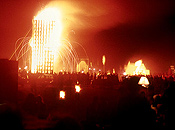 Once HELCO Tower was reduced to seething embers, the crowd continued across the desert, ending its journey at the City of Dis. This installation and performance was created and directed by artist Pepe Ozan. I’d plucked its name from Dante’s Inferno, but Pepe had actually entitled the performance The Arrival of the Empress Zoe. With proper operatic pomp, it enacted the arrival of a soul in Hell. In that year’s theme announcement, I alluded to it as concealing, “…the Ultimate Pit – a hidden and unhealing wound… this chasm is a fountainhead of boundless rage, appalling shame, and unendurable loneliness.”. This is, in fact, a literal rendition of the symptoms of narcissistic personality disorder, the premier mental illness in our age of mass consumption.
Once HELCO Tower was reduced to seething embers, the crowd continued across the desert, ending its journey at the City of Dis. This installation and performance was created and directed by artist Pepe Ozan. I’d plucked its name from Dante’s Inferno, but Pepe had actually entitled the performance The Arrival of the Empress Zoe. With proper operatic pomp, it enacted the arrival of a soul in Hell. In that year’s theme announcement, I alluded to it as concealing, “…the Ultimate Pit – a hidden and unhealing wound… this chasm is a fountainhead of boundless rage, appalling shame, and unendurable loneliness.”. This is, in fact, a literal rendition of the symptoms of narcissistic personality disorder, the premier mental illness in our age of mass consumption.
Among the visions I recall from that night are giant mantis-like insects elevated upon stilts. They stalked ominously through the performance area, interacting with the crowd. Another performance I remember involved two men. Naked, bestial, they were chained to the opposite ends of an enormous trunk. They’d carefully rehearsed their dance, a grotesque pas de deux. First one of them would seize his chain and pull the burden toward him, desperately attempting to possess it. His partner then reacted with a counter effort. Their movements were quite stylized and acrobatic. Weaving their bodies over, under and athwart their chains, they spiraled about, tracing a circuit around the central backdrop of the performance, the gothic towers of the City of Dis.
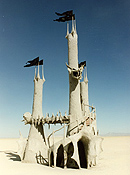 These tall tapering chimneys were coated with mud mined from a privately owned desert hot spring. This clay-like material was then applied to a superstructure of rebar and metal mesh. The result was mesmerizing. Fractally cracked, like the playa, the texture it produced when dried was riven with fissures. When, at the climax of the performance, a fire was ignited within the base of this clustered array, it luridly glowed, as if it were enmeshed by throbbing veins. After several minutes, it collapsed, and with it The Inferno disappeared.
These tall tapering chimneys were coated with mud mined from a privately owned desert hot spring. This clay-like material was then applied to a superstructure of rebar and metal mesh. The result was mesmerizing. Fractally cracked, like the playa, the texture it produced when dried was riven with fissures. When, at the climax of the performance, a fire was ignited within the base of this clustered array, it luridly glowed, as if it were enmeshed by throbbing veins. After several minutes, it collapsed, and with it The Inferno disappeared.

